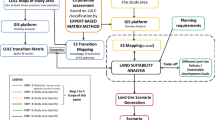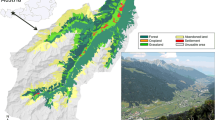Abstract
Land use and land cover (LULC) changes have significant influences on the water–energy–food (WEF) nexus, as the WEF nexus characteristics change naturally due to dynamic LULC changes. However, understanding the WEF nexus’ potential and characteristics in the watershed under the influence of LULC changes is less commonly explored. This study used the social network analysis (SNA) model to analyze the interaction between land use (LU) types and water, energy, and food nexus attributes. Moreover, we used regression analysis to analyze the impact of various LU types on the WEF nexus. The LULC maps of 1986, 2000, 2011, and 2019 were prepared by digital classification method with proper accuracy using satellite imagery. The results show that agroforestry is the dominant LU type, accounting for 25.8–53.1% from 1986 to 2019. Further, settlement increased a 100-fold, which shows the dynamic LULC changes. SNA computed the maximum inter-linkage for forest and water access attributes, while agroforestry and food attributes acted as bridge in the network. This shows that there was inter-dependence between LULC changes and the WEF nexus. This result suggests that LU dynamics can exert pressure on the WEF nexus’ resource potential, resulting in WEF insecurity. The analysis of impacts of LULC changes on the WEF nexus shows that the changes that occurred in major LUs (i.e., agroforestry, bare land, settlements, and grass land) had significantly impacted hydrological behaviors, energy characteristics, and food production potential. Understanding LULC changes helps us to conserve and manage WEF nexus resources and to resolve the current dilemmas between land, water, energy, and food sector policies and decisions to improve resource productivity, lower environmental pressure, and enhance human wellbeing and security.







Similar content being viewed by others
Notes
(L1 = land security, L2 = land size, L3 = land degradations, L4 = agricultural expansions, L5 = soil erosion, L6 = biodiversity loss, L7 = land uses, L8 = land tenure, L9 = land transfer, L10 = land marketing, L11 = land grabbing, L12 = land improvement, L13 = land features, L14 = soil and water conservations, E1 = traditional energy, E2 = energy demand, E3 = rural electrification, E4 = alternative energy, E5 = modern energy, E6 = energy security, 1E7 = energy supply, E8 = energy sources, E9 = energy efficiency, E10 = energy consumptions, water security (W1), hydrological variability (W2), droughts and floods (W3), water supply (W4), improved Water (W5), small reservoirs (W6), irrigation (W7), water demand (W8), water sources (W9), water management (W10), water use (W11), water infrastructure (W12), sedimentation (W13), crop production (F1), annual Yield (F2), food processing (F3), fertilizer use (F4), mechanization (F5), food demand (F6), food supply (F7), crop biomass (F8), food assistance (F9), food availability (F10), food prices (F11), income (F12), livestock and fish (F13), food security (F14).
References
Abebe, T., Wiersum, K., Bongers, F., & Sterck, F. (2006). Diversity and dynamics in homegardens of southern Ethiopia. In: Tropical homegardens (pp. 123–142). Springer, Berlin.
Biggs, E. M., Bruce, E., Boruff, B., Duncan, J. M., Horsley, J., Pauli, N., et al. (2015). Sustainable development and the water–energy–food nexus: A perspective on livelihoods. Environmental Science and Policy, 54, 389–397.
Bodin, Ö., & Crona, B. I. (2009). The role of social networks in natural resource governance: What relational patterns make a difference? Global Environmental Change, 19, 366–374.
Butts, C. T. (2008). Social network analysis with SNA. Journal of Statistical Software, 24, 1–51.
Chartres, C. J., & Noble, A. (2015). Sustainable intensification: Overcoming land and water constraints on food production. Food Security, 7, 235–245.
Chen, B., Han, M., Peng, K., Zhou, S., Shao, L., Wu, X., et al. (2018). Global land–water nexus: Agricultural land and freshwater use embodied in worldwide supply chains. Science of the Total Environment, 613, 931–943.
Desta, S., & Coppock, D. L. (2002). Cattle population dynamics in the southern Ethiopian rangelands, 198097. Rangeland Ecology and Management/Journal of Range Management Archives, 55, 439–451.
Elias, E., Seifu, W., Tesfaye, B., & Girmay, W. (2019). Impact of land use/cover changes on lake ecosystem of Ethiopia central rift valley. Cogent Food and Agriculture, 5, 1595876.
Genet, M. (2017). Groundwater flow direction, recharge and discharge zones identification in lower Gidabo Catchment, Rift Valley Basin, Ethiopia. Journal of Environment and Earth Science, 7, 32–39.
Gessese, B. H. (2018). Impact of land use/land cover change on rural communities’ livelihood of Ethiopia. Journal of Ecological Environment Science, 6, 1.
Grove, A. (1986). Geomorphology of the African Rift system. Geological Society, London, Special Publications, 25, 9–16.
Gulati, M., Jacobs, I., Jooste, A., Naidoo, D., & Fakir, S. (2013). The water–energy–food security nexus: Challenges and opportunities for food security in South Africa. Aquatic Procedia, 1, 150–164.
Hathaway, T. (2008). What cost Ethiopia’s dam boom. A look inside the Expansion of Ethiopia’s Energy Sector: International Rivers, people water, life.
Hoff, H. (2011a). Understanding the nexus: Background paper for the Bonn2011 Conference.
Hoff, H. (2011b). Understanding the nexus: Background paper for the Bonn2011 Nexus Conference. SEI.
Hurni, H., Abate, S., Bantider, A., Debele, B., Ludi, E., Portner, B., & Yitaferu, B., & Zeleke, G. (2010). Land degradation and sustainable land management in the highlands of Ethiopia.
Kanshie, T. K. (2002). Five thousand years of sustainability?: A case study on Gedeo land use (Southern Ethiopia).
Karlberg, L., Hoff, H., Amsalu, T., Andersson, K., Binnington, T., Flores-López, F., de Bruin, A., Gebrehiwot, S.G., Gedif, B., & Johnson, O. (2015). Tackling complexity: understanding the food–energy–environment nexus in Ethiopia's Lake Tana sub-basin. Water Alternatives, 8.
Ketema, H., Wei, W., Legesse, A., Wolde, Z., Temesgen, H., Yimer, F., & Mamo, A. (2020). Quantifying smallholder farmers’ managed land use/land cover dynamics and its drivers in contrasting agro-ecological zones of the East African Rift. Global Ecology and Conservation, 21, e00898.
Krasuska, E., Cadórniga, C., Tenorio, J. L., Testa, G., & Scordia, D. (2010). Potential land availability for energy crops production in Europe. Biofuels, Bioproducts and Biorefining, 4, 658–673.
Kurian, M. (2017). The water–energy–food nexus: Trade-offs, thresholds and transdisciplinary approaches to sustainable development. Environmental Science and Policy, 68, 97–106.
Laspidou, C. S., Mellios, N., & Kofinas, D. (2019). Towards ranking the water–energy–food–land use-climate nexus interlinkages for building a nexus conceptual model with a heuristic algorithm. Water, 11, 306.
Leck, H., Conway, D., Bradshaw, M., & Rees, J. (2015). Tracing the water–energy–food nexus: Description, theory and practice. Geography Compass, 9, 445–460.
Lee, S.-H., Taniguchi, M., Mohtar, R., Choi, J.-Y., & Yoo, S.-H. (2018). An analysis of the water–energy–food–land requirements and Co2 emissions for food security of rice in Japan. Sustainability, 10, 3354.
Leese, M., & Meisch, S. (2015). Securitising sustainability? Questioning the ‘water, energy and food–security nexus’. Water Alternatives, 8.
Maes, W. H., & Verbist, B. (2012). Increasing the sustainability of household cooking in developing countries: Policy implications. Renewable and Sustainable Energy Reviews, 16, 4204–4221.
Mehta, V. K., Haden, V. R., Joyce, B. A., Purkey, D. R., & Jackson, L. E. (2013). Irrigation demand and supply, given projections of climate and land-use change, in Yolo County, California. Agricultural Water Management, 117, 70–82.
Melese, S. M. (2016). Effect of land use land cover changes on the forest resources of Ethiopia. International Journal of Natural Resource Ecology and Management, 1, 51.
Meshesha, D. T., Tsunekawa, A., & Tsubo, M. (2012). Continuing land degradation: Cause–effect in Ethiopia’s Central Rift Valley. Land Degradation and Development, 23, 130–143.
Mohtar, R. H., & Lawford, R. (2016). Present and future of the water–energy–food nexus and the role of the community of practice. Journal of Environmental Studies and Sciences, 6, 192–199.
Otte, E., & Rousseau, R. (2002). Social network analysis: A powerful strategy, also for the information sciences. Journal of Information Science, 28, 441–453.
Pahl-Wostl, C. (2017). Governance of the water–energy–food security nexus: A multi-level coordination challenge. Environmental Science and Policy.
Parikka, M. (2004). Global biomass fuel resources. Biomass and Bioenergy, 27, 613–620.
Patra, S., Sahoo, S., Mishra, P., & Mahapatra, S. C. (2018). Impacts of urbanization on land use/cover changes and its probable implications on local climate and groundwater level. Journal of Urban Management, 7, 70–84.
Pfister, S., Bayer, P., Koehler, A., & Hellweg, S. (2011). Environmental impacts of water use in global crop production: Hotspots and trade-offs with land use. Environmental Science and Technology, 45, 5761–5768.
Prell, C., Hubacek, K., & Reed, M. (2009). Stakeholder analysis and social network analysis in natural resource management. Society and Natural Resources, 22, 501–518.
Rasul, G. (2014). Food, water, and energy security in South Asia: A nexus perspective from the Hindu Kush Himalayan region☆. Environmental Science and Policy, 39, 35–48.
Ringler, C., Bhaduri, A., & Lawford, R. (2013). The nexus across water, energy, land and food (WELU): Potential for improved resource use efficiency? Current Opinion in Environmental Sustainability, 5, 617–624.
Searchinger, T., & Heimlich, R. (2015). Avoiding bioenergy competition for food crops and land. Creating a Sustainable Food Future, 1–44.
Seyoum, W. M., Milewski, A. M., & Durham, M. C. (2015). Understanding the relative impacts of natural processes and human activities on the hydrology of the Central Rift Valley lakes, East Africa. Hydrological Processes, 29, 4312–4324.
Spera, S. A., Galford, G. L., Coe, M. T., Macedo, M. N., & Mustard, J. F. (2016). Land-use change affects water recycling in Brazil’s last agricultural frontier. Global Change Biology, 22, 3405–3413.
Sreevani, P. (2018). Wood as a renewable source of energy and future fuel. In: AIP Conference Proceedings. AIP Publishing LLC, p. 040007.
Stein, C., Barron, J., & Moss, T. (2014). Governance of the nexus: From buzz words to a strategic action perspective. Nexus Network Think Piece Series, Paper, 3, 1–23.
Sušnik, J., Chew, C., Domingo, X., Mereu, S., Trabucco, A., Evans, B., et al. (2018). Multi-stakeholder development of a serious game to explore the water–energy–food–land–climate nexus: The SIM4NEXUS approach. Water, 10, 139.
Temesgen, H., Wu, W., Legesse, A., Yirsaw, E., & Bekele, B. (2018). Landscape-based upstream–downstream prevalence of land-use/cover change drivers in southeastern rift escarpment of Ethiopia. Environmental Monitoring and Assessment, 190, 166.
Terrapon-Pfaff, J., Ortiz, W., Dienst, C., & Gröne, M.-C. (2018). Energising the WEF nexus to enhance sustainable development at local level. Journal of Environmental Management, 223, 409–416.
Waughray, D. (2011). Water security the water–food–energy–climate nexus: The World Economic Forum water initiative.
Weitz, N., Nilsson, M., & Davis, M. (2014). A nexus approach to the post-2015 agenda: Formulating integrated water, energy, and food SDGs. SAIS Review of International Affairs, 34, 37–50.
WoldeYohannes, A., Cotter, M., Kelboro, G., & Dessalegn, W. (2018). Land use and land cover changes and their effects on the landscape of Abaya-Chamo Basin, Southern Ethiopia. Land, 7, 2.
Yared, B. (2019). Estimation of catchment sediment yield using SWAT Model (Case Study Gidabo Dam, Rift Valley Basin, Ethiopia). Addis Ababa University.
Acknowledgments
We are grateful to the Chinese Government Scholarship Council (CSC) for giving the first author a chance to pursue his Ph.D. study in China. The authors are also indebted to the National Natural Science Foundation of China (41571176) and International Cooperation and Cultivation Project of Nanjing Agricultural University (Fund No. X201915) which enabled to conduct this research.
Author information
Authors and Affiliations
Corresponding author
Rights and permissions
About this article
Cite this article
Wolde, Z., Wei, W., Likessa, D. et al. Understanding the Impact of Land Use and Land Cover Change on Water–Energy–Food Nexus in the Gidabo Watershed, East African Rift Valley. Nat Resour Res 30, 2687–2702 (2021). https://doi.org/10.1007/s11053-021-09819-3
Received:
Accepted:
Published:
Issue Date:
DOI: https://doi.org/10.1007/s11053-021-09819-3




